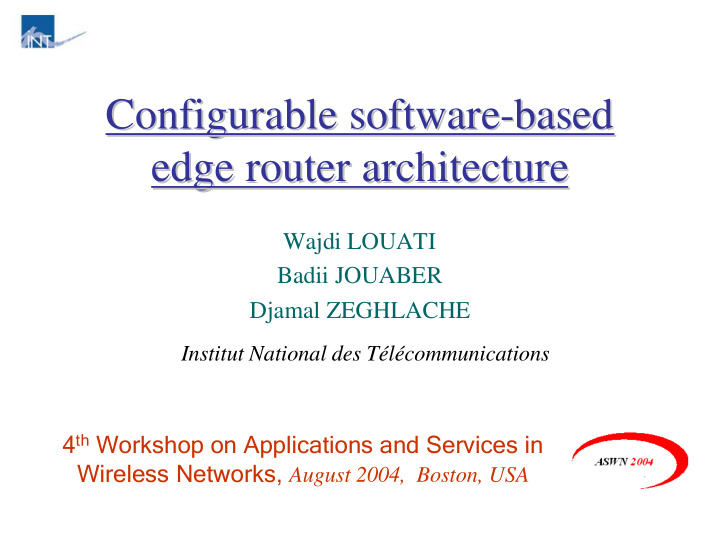



Configurable software- -based based Configurable software edge router architecture edge router architecture Wajdi LOUATI Badii JOUABER Djamal ZEGHLACHE Institut National des Télécommunications 4 th Workshop on Applications and Services in Wireless Networks, August 2004, Boston, USA
Outline Outline • Requirements and challenge Requirements and challenge • • Control and data plane separation: ForCES Control and data plane separation: ForCES • • Proposed model Proposed model • • Performance evaluation and results Performance evaluation and results • • Conclusion Conclusion • 2
Requirements and challenge Requirements and challenge The edge routers play a major role in NGN: • Control of connections, sessions, QoS, security, mobility .… • Achieve internetworking and cooperation Edge IP router requirements : • High Flexibility • Performance • Scalability Challenge: To increase the flexibility and adaptability of routers while at the same time offering higher packet forwarding performance. 3
Existing architectural solutions for IP routers Existing architectural solutions for IP routers • Software-based routers Control and data plane separation Control and data plane separation GPP + Flexibility: New features are easily added GPP Control Plane – Performance limitation (BGP, RSVP…) Software Control Plane Software • ASIC-based routers (BGP, RSVP…) Data Plane + Very fast (IP) PCI – Flexibility problem • Network processor-based routers Data Plane PCI + Flexibility, Performance, Scalability Hardware Hardware NP ASIC – Dependent Toolkit, Difficult deployment NIC NIC NIC NIC NIC 4
Control and data plane separation Control and data plane separation Management plane Configuration, monitoring, provisionning... COPS, SNMP... Control plane Routing, Signaling, Discovery ... Services APIs Scalable, extensible, interoperable CP to DP interconnect model ( ForCES Protocol ) Forwarding plane Classifiers, Meter, Scheduling, QoS... NPU NPU NPU NPU 5
ForCES (Forwarding and Control Element ForCES (Forwarding and Control Element Separation) Architecture Separation) Architecture • ForCES: Defines and standardizes the required interfaces, protocols and the exchange of information between the separated planes. Network Element (router) Control plane OSPF BGP RSVP …. CE CE CE CE ForCES Interface ForCES Data ForCES Control packets Protocol messages ForCES Interface Data plane Meter Shaper Classifier …. FE FE FE FE FE resources 6
Software- -based router improvement based router improvement Software • Software router can adopt the GPP same notion of plane separation Software Control Plane • Data plane can use high (packet flow) performance software PCI or Ethernet link Challenges: Data Plane • Which Software? (packet flow) Software GPP • How can we ensure the NIC NIC interaction between ForCES and the software? 7
Modular router: Click Modular router: Click • Developed by MIT • Modular, flexible, extensible and configurable • Built from packet processing modules called « Elements ». Click Element • Software component representing a unit of router processing • Interconnected interfaces « connections » SMP Click • Provides both flexibility and performance on multiprocessor platforms 8
Our proposed Software router design based on Our proposed Software router design based on the plane separation approach the plane separation approach Management Plane Forwarding path configuration manager interface LFB PollDevice PollDevice CE Routing LFB API Services Classifier Classifier Forwarding plane ForCES ForCES LFB Forwarding Protocol Protocol Control Plane CE Signaling LFB ToDevice ToDevice SMP Click IP packet processing 9
Dynamic adaptation of edge routers Dynamic adaptation of edge routers VPN Tunnel 10
Dynamic decision in the edge router Dynamic decision in the edge router @IP, Port DSCP SLA (Rate) In-profile traffic Traffic Marker Classifier Meter Scheduler Out-of-profile traffic Dynamic decision Load High Dropping (Out-of-profile) Monitoring Medium Load Rate Shaping Load Low Accepting Forwarding path configuration manager interface Click DiffServ function 11
Dynamic behavior of an auto- - Dynamic behavior of an auto configuration edge router configuration edge router 12
Additional delay caused by dynamic Additional delay caused by dynamic configurations configurations 60 50 Additional Delay (us) 40 80 Mbits/s 30 100 Mbits/s 150Mbits/s 20 10 0 0 1 2 10 100 1000 Nb of configurations per second 13
Effect of dynamic configurations Effect of dynamic configurations on the Round Trip Time on the Round Trip Time TCP throughput Ping Average RTT 1000 710 950 Aggregate throughput (Mbits/sec) 700 900 850 690 800 RTT ( µs ) 750 680 700 670 650 600 660 550 500 650 0 1 10 100 1000 Number of re-configurations per second 14
Conclusion Conclusion • Improvement of the Software based router design to achieve performance requirement. • The proposed design is based on: – Plane separation: ForCES architecture – SMP Click language (Forwarding plane) – Forwarding path configuration manager interface • The experienced marginal delays and packet losses are a favorable sign for the use of software based routers using the separation principle and the SMP Click language. • Larger scalability studies should comfort these findings and foster the use of these routers. 15
Thank you ! Thank you !
Losses versus aggregate rate Losses versus aggregate rate 0,9 0,8 % packets loss (x10 -4 ) 0,7 0,6 0,5 0,4 0,3 0,2 0,1 0 0 50 100 150 160 170 180 190 200 Rate (Mbits/s) 17
Recommend
More recommend